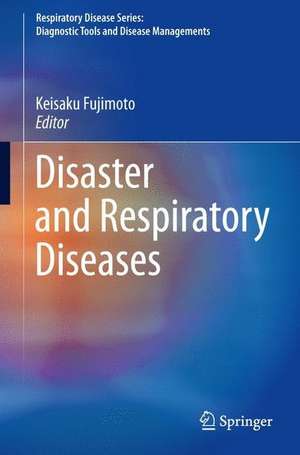Disaster and Respiratory Diseases: Respiratory Disease Series: Diagnostic Tools and Disease Managements
Editat de Keisaku Fujimotoen Limba Engleză Hardback – 28 ian 2019
Disaster and Respiratory Diseases is a valuable resource for all medical staff, including physicians involved in primary care, respiratory medicine and infection control and emergency medicine, as well as respiratory surgeons. Itis also useful to national and regional governments concerned about anti-disaster measures.
Preț: 655.34 lei
Preț vechi: 689.83 lei
-5% Nou
Puncte Express: 983
Preț estimativ în valută:
125.44€ • 136.30$ • 105.44£
125.44€ • 136.30$ • 105.44£
Carte tipărită la comandă
Livrare economică 18-24 aprilie
Preluare comenzi: 021 569.72.76
Specificații
ISBN-13: 9789811325977
ISBN-10: 9811325979
Pagini: 171
Ilustrații: VIII, 178 p. 57 illus., 38 illus. in color.
Dimensiuni: 155 x 235 mm
Greutate: 0.5 kg
Ediția:1st ed. 2019
Editura: Springer Nature Singapore
Colecția Springer
Seria Respiratory Disease Series: Diagnostic Tools and Disease Managements
Locul publicării:Singapore, Singapore
ISBN-10: 9811325979
Pagini: 171
Ilustrații: VIII, 178 p. 57 illus., 38 illus. in color.
Dimensiuni: 155 x 235 mm
Greutate: 0.5 kg
Ediția:1st ed. 2019
Editura: Springer Nature Singapore
Colecția Springer
Seria Respiratory Disease Series: Diagnostic Tools and Disease Managements
Locul publicării:Singapore, Singapore
Cuprins
Part I : Respiratory Injury Directly Induced by a Disaster.- Chapter 1: Dust, asbestos, and sludge exposure: What kinds of respiratory injuries are caused by disaster-induced dust, asbestos, and sludge exposure?.- Chapter 2: Tsunami lung in Great East Japan Earthquake 2011: clinical time course, feature, pathogenesis and treatment.- Chapter 3: Respiratory tract burns, traumatic pulmonary contusions, crushing death, and crush syndrome: What kinds of lung injury occur by respiratory tract burn, traumatic contusion, and crushing syndrome?.- Part II: Respiratory Disturbance by Aggravation of the Living Environment.- Chapter 4: Respiratory infection and aggravation of pulmonary disease related to environmental hygiene aggravation: What types of respiratory infection and aggravation of respiratory diseases are increased by aggravation of environmental hygiene?.- Chapter 5: Aggravation of asthma by cold, fatigue, stress, or discontinuation of medicines: What should we measures and preventsworse of asthma control induced by the aggravation of the environmental hygiene and/or the stopping medicine?.- Chapter 6: Exacerbation of COPD by air pollution, cold temperatures, or discontinuation of medicine: what should be measured to help prevent it?.- Chapter 7: Onset of DVT or pulmonary thromboembolism related to the life in a car or narrow shelter: What should we do to prevent the onset of the pulmonary thromboembolism?.- Part III: Aggravation of Existing Respiratory Diseases by the Lack of Health Resource Due to The Lifeline Stoppage.- Chapter 8 : What a patient and his family should do when unable to continue home oxygen therapy and home mechanical ventilation during a blackout: When unable to continue home oxygen therapy and non-invasive positive pressure ventilation due to a power outage, what should the patient and family member(s) do?.- Chapter 9: Aggravation of the existing respiratory diseases by the loss or difficulty in supplying of medicines and medical application: What happened and what measurements should the community and the patient and his family do when the medicines for the existing respiratory disease are lost or not supplied?.- Chapter 10: Aggravation of the existing respiratory diseases due to transportation stoppage, closure of the medical institution, and shortage of doctors: What measurements securing health resources and what actions for the supply of health resources are talked about?.- Part IV: Countermeasures Against Disaster for the Patients with Respiratory Diseases.- Chapter 11: Anti-disaster measures in local public entities for patients prescribed long-term oxygen therapy:Have local public entities made appropriate anti-disaster measures for patients prescribed long-term oxygen therapy?.- Chapter 12: Anti‐disaster measures for patients: What measures can patients take to prepare for disasters?
Notă biografică
Volume Editor
Keisaku Fujimoto, Department of Clinical Laboratory Sciences, Shinshu University School of Health Sciences
Series Editors
Hiroyuki Nakamura, Department of Respiratory Medicine, Tokyo Medical University, Ibaraki Medical Center, Ibaraki, Japan
Kazutetsu Aoshiba, Department of Respiratory Medicine, Tokyo Medical University, Ibaraki Medical Center, Ibaraki, Japan
Kazutetsu Aoshiba, Department of Respiratory Medicine, Tokyo Medical University, Ibaraki Medical Center, Ibaraki, Japan
Textul de pe ultima copertă
This book provides valuable data on the outbreak, aggravation, treatment and prevention of respiratory diseases based on prior experiences of natural disasters such as earthquakes and tsunamis. Poor hygiene and air pollution can lead to the onset of pneumonia and other respiratory disease, while a lack of medical supplies aggravates existing pulmonary diseases such as chronic obstructive pulmonary disease and asthma. Furthermore, there are cases where those forced to live in cramped conditions, such as cars, following a disaster have developed pulmonary thromboembolism as a result of deep vein thrombosis. The large numbers of patients diagnosed with respiratory diseases make understanding the links between natural disasters and pulmonary disease vital.
Disaster and Respiratory Diseases is a valuable resource for all medical staff, including physicians involved in primary care, respiratory medicine and infection control and emergency medicine, as well as respiratory surgeons. Itis also useful to national and regional governments concerned about anti-disaster measures.
Disaster and Respiratory Diseases is a valuable resource for all medical staff, including physicians involved in primary care, respiratory medicine and infection control and emergency medicine, as well as respiratory surgeons. Itis also useful to national and regional governments concerned about anti-disaster measures.
Caracteristici
Provides valuable data on the outbreak, aggravation, measures and prevention of respiratory diseases, based on prior experiences Explores the outbreak, aggravation, treatment and prevention of respiratory diseases based on prior experiences of natural disasters such as earthquakes and tsunamis Addresses the importance of the links between natural disasters and pulmonary disease Valuable resource for all medical staff, including physicians involved in primary care, respiratory medicine and infection control and emergency medicine, as well as respiratory surgeons










